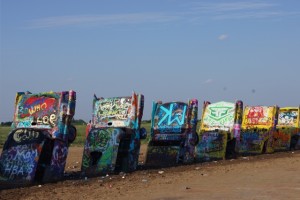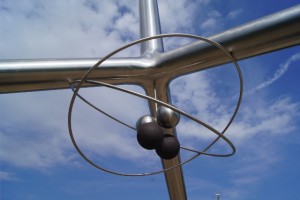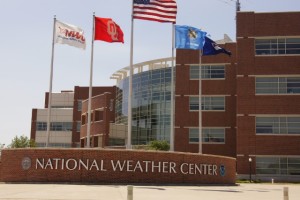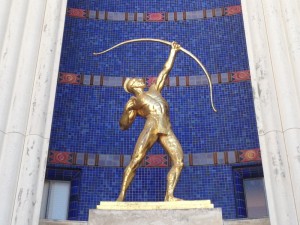 The Hall of State at Fair Park is a one-stop primer in Texas history. This opulent showcase of Texas pride opened its doors to the public during the 1936 Texas Centennial. Years later, the Hall of State continues to educate visitors. Today, the Dallas Historical Society manages the museum.
The Hall of State at Fair Park is a one-stop primer in Texas history. This opulent showcase of Texas pride opened its doors to the public during the 1936 Texas Centennial. Years later, the Hall of State continues to educate visitors. Today, the Dallas Historical Society manages the museum.
Hall of Heroes
Like most of the buildings at Fair Park, the Hall of State is classic Art Deco, inside and out. Designed by Donald Barthelme, the building is shaped in an inverted ‘T’ – appropriate for a building that commemorates 400 years of Texas history. Every statue, carving, and mural in the Hall of State depicts some aspect of state (and pre-statehood) history and culture.
The towering, gilded statue, Tejas Warrior greets visitors at the building’s grand entrance. The blue, mosaic tiling behind the statue represents our state flower, the bluebonnet. Step inside the building to meet Texas fore fathers in the Hall of Heroes. Stephen Austin and Sam Houston are among the six, life-sized bronze statues.
The Great Hall
From the Hall of Heroes, you enter the Great Hall. I love this room. I’m always amazed at the detail packed all into a single space. Dominating the back wall, the brilliant gold medallion, divided into six pie-shaped reliefs, symbolizes the six nations (France, Mexico, Spanish, Confederacy, Texas Republic, and United States) who have claimed this area. Remarkably detailed murals cover the left and right walls, telling our history in a series of painted scenes.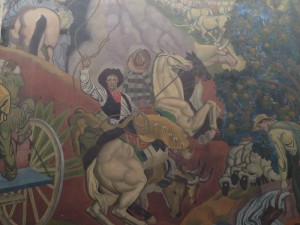 The murals cover every aspect of Texas history from the 1500 arrival of Europeans to images of higher education and state industries. On the floor, you’ll find mosaics of Texas animals, like the jackrabbit and horned lizard. Even the ceiling in the Great Hall is chocked full of symbolism – designed by George Davidson to represent Aztec motifs of roadrunner, armadillo, and rattlesnake. You can simply spend hours finding new tidbits of history and symbolism throughout the room.
The murals cover every aspect of Texas history from the 1500 arrival of Europeans to images of higher education and state industries. On the floor, you’ll find mosaics of Texas animals, like the jackrabbit and horned lizard. Even the ceiling in the Great Hall is chocked full of symbolism – designed by George Davidson to represent Aztec motifs of roadrunner, armadillo, and rattlesnake. You can simply spend hours finding new tidbits of history and symbolism throughout the room.
East and West Texas
To the left of the Great Hall, are the East Texas room and G.B. Dealey Library (West Texas). You’ll find murals again in each room, this time above the entrances. The East room murals portray pre-and post-oil Texas. Beautiful, translucent photos by Polly Smith, a Texas photographer active in the 1930s, decorate the walls. Continue on to the library and you’ll discover a completely different motif, this time using brightly colored ceramic tiles on floor and walls.
Storage
Unfortunately, you currently can’t visit the North and South Texas rooms. The historical society lost their off-site warehouse, and now use these rooms for storage of artifacts and documents. Still, you can virtually visit the rooms via an awesome online tour of the Hall of State.
When you go
The Hall of State is in Fair Park at 3939 Grand Avenue, Dallas. Enter the park at Gate 3 for easiest access. Touring the building adds another dimension to our state, especially for children studying Texas history in school. On the second Tuesday of the month, March through September, the Dallas Historical Society hosts a brown bag lecture series (appropriate for teens and adults). The Hall of State is open Tuesday through Saturday from 9 a.m. to 5 p.m., and on Sunday from 1 to 5 p.m. Entrance to the Hall of State is free, though donations are welcome.

